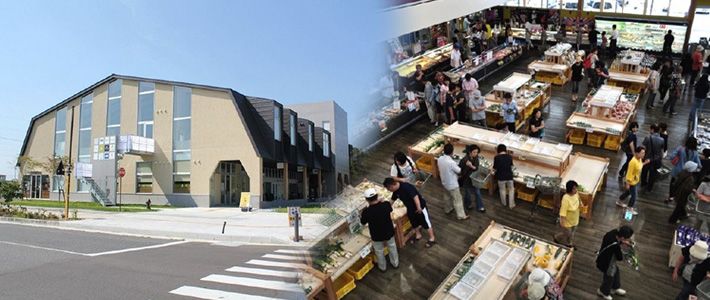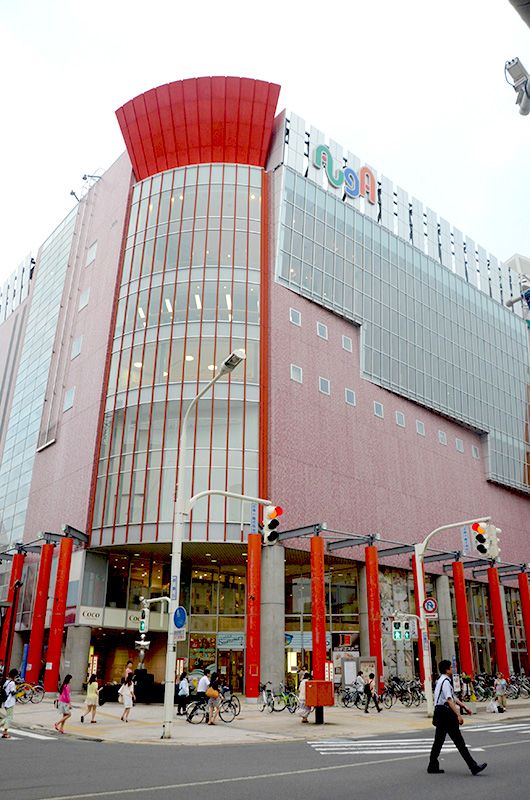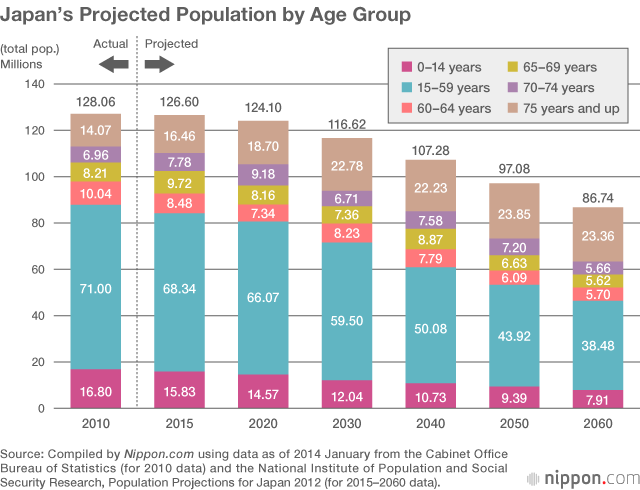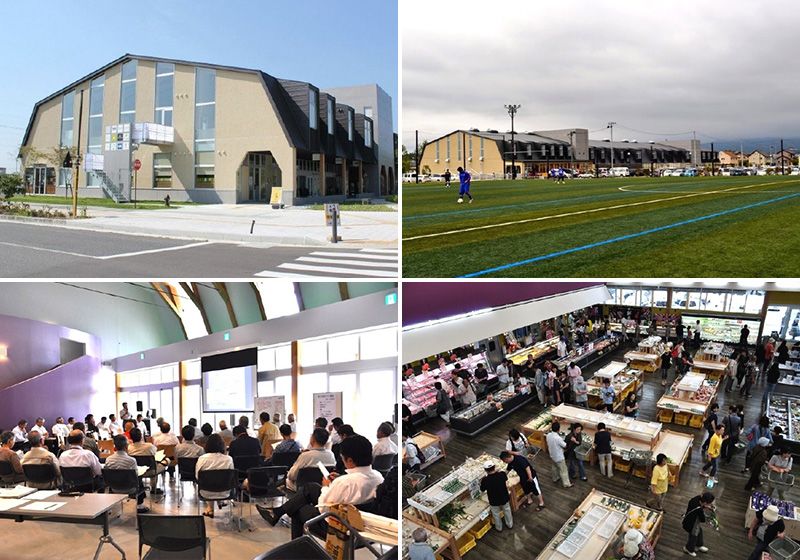
Regional Revitalization and the Market: An Interview with Kinoshita Hitoshi
Politics Economy Society- English
- 日本語
- 简体字
- 繁體字
- Français
- Español
- العربية
- Русский
INTERVIEWER We’ve seen some regional revitalization success stories, but we also hear of cases in which a project intended to revitalize a community ended up contributing to its decline. Can you talk about some of the failures?
 Festival City Auga, a multipurpose building that opened in 2001 near Aomori Station as part of a plan to revitalize downtown Aomori, capital of Aomori Prefecture. (Photo: Mainichi Shimbun/Aflo)
Festival City Auga, a multipurpose building that opened in 2001 near Aomori Station as part of a plan to revitalize downtown Aomori, capital of Aomori Prefecture. (Photo: Mainichi Shimbun/Aflo)
KINOSHITA HITOSHI There are countless examples. One notorious case is the Auga building, part of the Aomori Station redevelopment plan that was supposed to revitalize downtown Aomori. It was built at a cost of 18.5 billion yen, with public subsidies covering 8.5 billion of that. Everything proceeded according to plan, yet the facility has operated in the red ever since it opened in January 2001. The local government keeps allocating emergency funding and emergency financing to prop it up, but it’s still not on a viable footing. [Retail facilities on the first to fourth floors were closed indefinitely in February 2017. —Ed.] Instead of spurring revitalization, construction projects like this simply drain the local government’s coffers. Eventually they become highly visible symbols of the area’s economic decline.
In 2014 my Area Innovation Alliance published a report on seven failed local redevelopment projects. We titled it the Gravestone Series. It’s attracted a lot of interest because, while the government is keen on sharing what it calls best practices in regional redevelopment, it never talks about the failures. The fact is that the model of regional development that took shape in the era of rapid growth has become dysfunctional, and unless we face that fact and devise some workable solutions, there’s not going to be any regional renaissance.
INTERVIEWER Can you identify any characteristics that these failed revitalization projects have in common?
KINOSHITA The success stories and best practice in regional revitalization generally owe their success to the efforts of local citizens and businesses, not to some government policy or program. The bureaucrats in Tokyo seek out such “model projects” and honor them with awards and make them the basis for grant programs, which provide funding for similar projects in other locales.
It sounds sensible, but government funding has a way of warping the structure of a project. When a project’s funding is guaranteed by some big program, the project leaders inevitably start basing their decisions on the grantor’s philosophy and policies instead of the profit motive. That’s not a viable formula for regional revitalization. Projects that follow best practices and look very promising at the outset have been known to turn into failures after three years of government grants. Then, that approach to revitalization and the project that pioneered it simply disappear from the agency’s list of best practices and model projects.
A common feature of successful undertakings is that they’re planned and implemented independently, without reliance on any sort of funding other than private business capital. And a common feature of failed regional revitalization plans, to answer your question, is that they rely on non-business capital and as a consequence lose their focus on the bottom line.
The projects we carry out through community development companies all put business considerations first. If they can’t operate at a profit, they go out of business. That’s as it should be. That’s why everyone works so hard to ensure their success.
Each of the projects we looked at [in part 1] is a business investment that makes use of existing assets to yield high returns, while also benefiting the community and contributing to its sound development. A local revitalization project that’s driven solely by a sense of mission without regard to profits isn’t noble or virtuous, it’s just irresponsible.
Nowadays everyone gives lip service to “regional revitalization,” but many of the so-called revitalization projects being undertaken by local governments are exactly the same kinds of boondoggles that have been eating up taxpayer money for decades. Programs that eat up taxes without generating economic returns aren’t going to revitalize declining regional economies. In fact, projects like these are largely to blame for the current situation.
The plight of the regions is not Tokyo’s fault. Year after year the central government has redistributed fiscal resources from Tokyo to the rural prefectures through the local allocation tax and other transfers. If all that money had been invested in economically viable projects that pumped money back into the economy instead of in boondoggles, regional communities wouldn’t be in the fix they’re in today.
Demographics as a Red Herring
INTERVIEWER The Japan Policy Council [chaired by Masuda Hiroya] earlier published a rather shocking report predicting that close to half of Japan’s 1,800 regional cities are in danger of extinction by the year 2040. What are your thoughts on the Masuda report?
KINOSHITA The report said that by 2040 many of Japan’s municipalities will be depopulated to the point where they may no longer be viable as municipalities. This was sensationally trumpeted as “the death of the regions,” which has led to a lot of misunderstanding.
Of course, regional communities don’t just vanish overnight. The population dwindles, but people continue to live there. The problem is that, for many communities, the old style of local government and the one-size-fits-all system of local administration are no longer sustainable given today’s demographic and fiscal realities. If that’s the case, then we need to implement some basic organizational and administrative reforms.
The prefecture system itself dates all the way back to the Meiji era. It time to talk seriously about shifting to a state system. There’s still plenty of room for merger and consolidation of municipalities. And many administrative functions could be consolidated and streamlined. Some of the functions being carried out separately by lots of little municipal governments could be accomplished by a single regional call center. There are countless ways to make local government more efficient.
But no one is talking about reducing the cost of government. All of the discussion is focused on the population issue, which is a red herring. The fact is that Japan’s population is in decline, and there’s no way to reverse that trend over the next few decades. We have to accept the fact and figure out a way of keeping local communities viable despite their declining population.

It seems to me that local governments should be coming to grips with the imminent danger of fiscal collapse instead of worrying about population projections for 2040. Quite a few communities are in serious trouble right now. But instead of grappling with spending issues, they’re shifting the blame to things like birthrate and migration, as if we could simply reverse those trends and solve all their problems.
Toward a Philosophy of Self-Reliance
A basic prerequisite for regional revitalization is fiscal sustainability at the local level. Local governments have to shift to an independent, fiscally responsible footing instead of just hatching new plans for using up all the funds they get from the central government. They need to start scrutinizing every public investment they make from the standpoint of economic returns.
Instead, they’re talking about solving their problems by getting young people to move out from the Tokyo metropolitan area or by transferring some of Tokyo’s urban functions to regional cities. It’s all about “give us some of what Tokyo’s got.” This is very divisive, and it’s not in the nation’s best interest, because if you take away Tokyo’s assets and resources, it will lose out to other East Asian cities. It’s time for regional communities to start figuring out how to make the most of their own assets instead of trying to be like Tokyo.
This means setting priorities and focusing on them. A regional community has to decide what it can and can’t do. It can’t be all things to all people, like a big city. This is one of the lessons to be learned from the Ogal project. The mayor opened up the door to a whole new approach when he decided that the municipal government couldn’t afford any more construction projects. Other successful projects were made possible by a decision to invest in renovation and redevelopment of existing assets instead of building big new developments in their place. Moving forward, each region will need to develop its own unique business model leveraging the public and private assets it’s already accumulated.
 Ogal Plaza in Shiwa, Iwate Prefecture.
Ogal Plaza in Shiwa, Iwate Prefecture.
The central government’s budget for this fiscal year includes new subsidies for regional revitalization. Unless local governments use those funds differently than they have in the past, they’re not going to attract new business or investment over the long run. The key is to come up with money-making programs that can support themselves without depending on subsidies. Regional revitalization isn’t about taking what belongs to others. It’s about learning to stand on one’s own two feet.
(Originally published in Japanese on May 7, 2015. Banner photo: Ogal Plaza in Shiwa, Iwate Prefecture, a hybrid public-private facility that offers a promising new model for regional revitalization. Photo courtesy of Kinoshita Hitoshi, Area Innovation Alliance.)